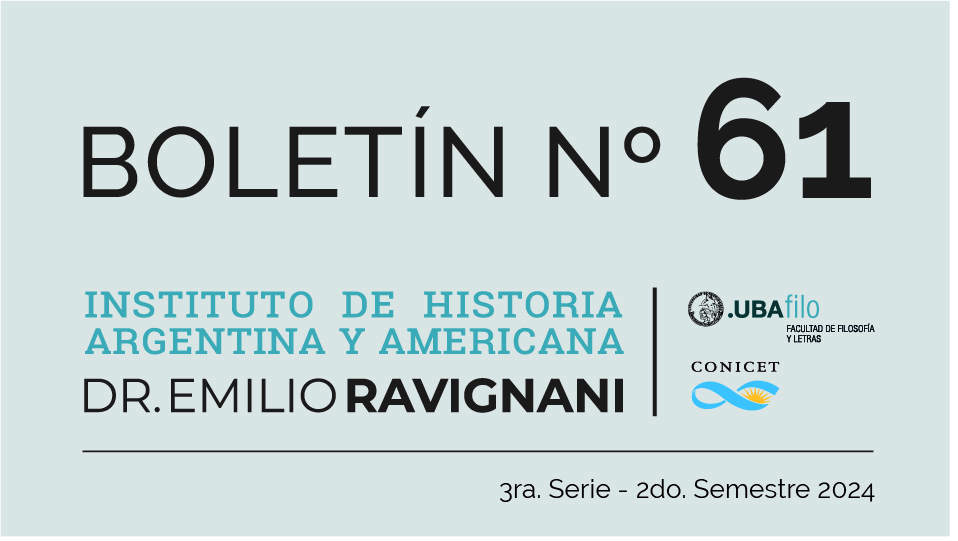Don Cándido Sotomayor y su consistencia en la percepción de la calidad
Resumen
Durante veintiséis años, el cura de Los Llanos, don Cándido Sotomayor, llevó a cabo una labor de ordenamiento y clasificación del curato que resulta sorprendente dada la dinámica de cambio constante que caracterizaba a esa comunidad hacia finales del período colonial. En este sentido, pareciera que su labor no consistió en una mera reclasificación de la población, sino más bien en una categorización personal y consistente basada en los criterios implícitos de percepción de la calidad. Las categorías utilizadas por Sotomayor revelan tanto los valores arraigados en su posición en la jerarquía social como los cambios en los imaginarios raciales vigentes y su resignificación hacia el final de la era colonial. Es importante resaltar, en sintonía con lo expresado por las autoras, las oportunidades que el análisis de la labor de Sotomayor brinda para examinar los enfoques a través de los cuales los censistas observaban la realidad. Asimismo, permite contrastar percepciones, consistencias y reforzamientos de ciertos atributos implícitos de la calidad a lo largo del tiempo. Esta mirada detallada sobre el trabajo y los criterios de clasificación del religioso nos ofrece una ventana única para comprender cómo se construía y percibía la calidad en esa época, así como para analizar los cambios y continuidades en las valoraciones sociales y raciales a lo largo del periodo colonial.Descargas
Citas
Briones, C. (2005). Formaciones de alteridad; contextos globales, procesos nacionales y provinciales. En C. Briones, Cartografías Argentinas. Políticas indigenistas y formaciones provinciales de alteridad. Buenos Aires: Antropofagia.
França Paiva, E. (2020). Nombrar lo nuevo. Una Historia léxica de Iberoamérica, entre los siglos XVI y XVIII. Las dinámicas de mestizaje y el mundo del trabajo. Chile: Editorial Uni-versitaria.
De la Cadena, M. (2008). Formaciones de indianidad. Articulaciones raciales, mestizaje y nación en América Latina. Popayán: Envión Editores.
De la Fuente, A. (2006). Los hijos de Facundo. Caudillos y montoneras en la provincia de La Rioja durante el tiempo de formación del Estado nacional argentino (1853-1870). Bue-nos Aires: Prometeo.
Farberman, J. y Ratto, S. (Comps.) (2005). Introducción. En Historias mestizas en el Tucu-mán colonial y las pampas (siglo XVII-XIX). Buenos Aires: Biblos.
Fontenla, M. (2018). Mestizaje colonial y mestizajes estratégicos. Una mirada crítica a la relación entre historia regional e historia indígena. Anuario, (30), pp. 11-44 [en línea] http://anuariodehistoria.unr.edu.ar/ojs/index.php/Anuario/index
Grosso, J. L. (2008). Indios muertos, negros invisibles: hegemonía, identidad y añoranza. Córdoba: Universidad Nacional de Catamarca, Encuentro Grupo Editor.
Guzmán, F. (2010). Los claroscuros del mestizaje. Negros, indios y castas en la Catamarca colonial. Córdoba: Universidad Nacional de Catamarca, Encuentro Grupo Editor.
Guzmán, F. (2013). Performatividad social de las (sub)categorías coloniales. Mulatos, par-dos, mestizos y criollos en tiempos de cambios, guerra y política, en el interior de Argentina. En F. Guzmán y L. Geler (Eds.), Cartografías afrolatinomericanas. Perspectivas situadas para análisis transfronterizos (pp. 57-86). Buenos Aires: Biblos.
Hall, S. (2005). Identidade Cultural na Pós Modernidade. Rio de Janeiro: DP&A.
Hall, S. (2010). Sin garantías. Trayectorias y problemáticas en estudios culturales. Popayán-Lima-Quito: Envión Editores.
Hering Torres, M. (2011a). La limpieza de sangre. Problemas de interpretación, acercamien-tos históricos y metodológicos. Historia crítica, (45), pp. 32-55.
Hering Torres, M. (2011b). Color, pureza y raza. La calidad de los sujetos coloniales. En H. Bonilla (Ed.), La cuestión colonial (pp. 451-470). Bogotá: Universidad Nacional de Colombia.
Restrepo, E. (2011). Articulaciones de negridad: políticas y tecnologías de la diferencia en Colombia. Documento de trabajo. México: CLACSO.
Stolcke, V. (1992). Racismo y sexualidad en la Cuba colonial. Madrid: Alianza Editorial.
Stolcke, V. (2008). Los mestizos no nacen, se hacen. En V. Stolcke y A. Coello (Eds.), Identidades ambivalentes en América Latina, Siglos XVI-XXI. Barcelona: Bella Terra.
Derechos de autor 2024 Boletín del Instituto de Historia Argentina y Americana Dr. Emilio Ravignani

Esta obra está bajo licencia internacional Creative Commons Reconocimiento-NoComercial 4.0.
Los derechos de autor son cedidos al Boletín, pero los autores podrán recuperarlos y reproducir su trabajo en otros medios o formatos mediante una solicitud por escrito al Comité Editor. En esos casos, se citará al Boletín como primera publicación del trabajo.
Las obras quedan licenciadas bajo una Licencia Creative Commons Atribución-No Comercial 4.0 Internacional, que permite a otros compartir el trabajo con un reconocimiento de su autoría y la publicación inicial en esta revista.
También, mediando solicitud por escrito al Comité Editor del Boletín, los autores pueden establecer por separado acuerdos adicionales para la distribución no exclusiva de la versión de la obra publicada en esta revista (por ejemplo, situarlo en un repositorio institucional o publicarlo en un libro), con un reconocimiento de su publicación inicial aquí. No se permiten usos comerciales.



















